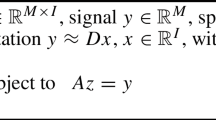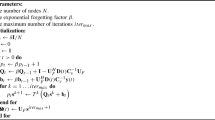Abstract
This paper considers the robust recovery problem of sparse signal with sparse Bayesian learning (SBL) in noisy environments. Most of the current SBL algorithms are constructed on the optimization problem using the square loss, which mainly deals with Gaussian noise. However, real measurements are often contaminated by an unknown distributed noise that is unlikely to be Gaussian. To prevent performance degradation of SBL in such cases, we propose a robust sparse Bayesian learning method with a simple but effective hierarchical noise model. Using this model, the resultant loss is made up of a weighted error measure and a priori-dependent constraint on the weight, and then provides the flexibility for resisting the outliers and adapting to the real noise. A type-II Bayesian estimate is performed to infer the related model parameter and the unknown sparse signal. The advantage of our method is demonstrated by extensive experiments on synthetic data and real radio tomographic imaging data.













Similar content being viewed by others
Data Availability
The datasets generated during and/or analyzed during the current study are available from the corresponding author on reasonable request.
Notes
We use LAD as short for LAD-LASSO to save space in the figures.
References
C. Alippi, M. Bocca, G. Boracchi, N. Patwari, M. Roveri, RTI goes wild: Radio tomographic imaging for outdoor people detection and localization. IEEE Trans. Mob. Comput. 15(10), 2585–2598 (2015)
O. Arslan, Weighted LAD-LASSO method for robust parameter estimation and variable selection in regression. Comput. Stat. Data Anal. 56(6), 1952–1965 (2012)
S.D. Babacan, R. Molina, A.K. Katsaggelos, Bayesian compressive sensing using Laplace priors. IEEE Trans. Image Process. 19(1), 53–63 (2010)
M. Bocca, O. Kaltiokallio, N. Patwari, Radio tomographic imaging for ambient assisted living, in Evaluating AAL Systems Through Competitive Benchmarking, Springer (2013), pp. 108–130
B. Efron, T. Hastie, I. Johnstone, R. Tibshirani et al., Least angle regression. Ann. Stat. 32(2), 407–499 (2004)
J. Fang, Y. Shen, H. Li, P. Wang, Pattern-coupled sparse Bayesian learning for recovery of block-sparse signals. IEEE Trans. Signal Process. 63(2), 360–372 (2015)
A.C. Faul, M.E. Tipping, Analysis of sparse bayesian learning. Adv. Neural Inf. Process. Syst. 14, 383–389 (2002)
K.L. Gemba, S. Nannuru, P. Gerstoft, Robust ocean acoustic localization with sparse Bayesian learning. IEEE J. Sel. Top. Signal Process. 13(1), 49–60 (2019)
Y. Guo, K. Huang, N. Jiang, X. Guo, Y. Li, G. Wang, An exponential-Rayleigh model for RSS-based device-free localization and tracking. IEEE Trans. Mob. Comput. 14(3), 484–494 (2015)
L. Hu, Z. Wu, L. Zhang, C. Tian, Fast recovery of non-negative sparse signals under heterogeneous noise, in 9th IEEE International Conference on Wireless Communications and Signal Processing (2017), pp. 1–6
K.D. Huang, Y. Guo, X.M. Guo, G.L. Wang, Heterogeneous Bayesian compressive sensing for sparse signal recovery. IET Signal Process. 8(9), 1009–1017 (2014)
S. Ji, L. Carin, Bayesian compressive sensing and projection optimization, in Proceedings of the 24th ACM International Conference on Machine Learning (2007), pp. 377–384
S. Ji, Y. Xue, L. Carin, Bayesian compressive sensing. IEEE Trans. Signal Process. 56(6), 2346–2356 (2008)
S. Liu, Y. Huang, H. Wu, C. Tan, J. Jia, Efficient multi-task structure-aware sparse Bayesian learning for frequency-difference electrical impedance tomography. IEEE Trans. Ind. Inform. PP(99), 1–1 (2020)
S. Liu, H. Wu, Y. Huang, Y. Yang, J. Jia, Accelerated structure-aware sparse Bayesian learning for three-dimensional electrical impedance tomography. IEEE Trans. Ind. Inform. 15(9), 5033–5041 (2019)
Y. Luo, K. Huang, X. Guo, G. Wang, A hierarchical RSS model for RF-based device-free localization. Pervasive Mob. Comput. 31, 124–136 (2016)
N. Patwari, J. Wilson, RF sensor networks for device-free localization: Measurements, models, and algorithms. Proc. IEEE 98(11), 1961–1973 (2010)
W. Si, X. Qu, Z. Qu, P. Zhao, Off-grid doa estimation via real-valued sparse Bayesian method in compressed sensing. Circuits Syst. Signal Process. 35(10), 3793–3809 (2016)
S. Tan, K. Huang, B. Shang, X. Guo, G. Wang, Sparse Bayesian learning with joint noise robustness and signal sparsity. IET Signal Process. 11(9), 1104–1113 (2017)
R. Tibshirani, Regression shrinkage and selection via the LASSO. J. R. Stat. Soc. Ser. B-Stat. Methodol. 267–288, (1996)
M.E. Tipping, Sparse Bayesian learning and the relevance vector machine. J. Mach. Learn. Res. 1, 211–244 (2001)
M.E. Tipping, A. Faul, Fast marginal likelihood maximisation for sparse bayesian models, in 9th International Workshop Artificial Intelligence and Statistics, (2003), pp. 1–12
J.A. Tropp, A.C. Gilbert, Signal recovery from random measurements via orthogonal matching pursuit. IEEE Trans. Inf. Theory 53(12), 4655–4666 (2007)
D.J. Tylavsky, G.R.L. Sohie, Generalization of the matrix inversion lemma. Proc. IEEE 74(7), 1050–1052 (1986)
H. Wang, G. Li, G. Jiang, Robust regression shrinkage and consistent variable selection through the LAD-LASSO. J. Bus. Econ. Stat. 25(3), 347–355 (2007)
L. Wang, L. Zhao, L. Yu, J. Wang, G. Bi, Structured Bayesian learning for recovery of clustered sparse signal. Signal Process. 166, 107255 (2020)
J. Wilson, N. Patwari, Radio tomographic imaging with wireless networks. IEEE Trans. Mob. Comput. 9(5), 621–632 (2010)
J. Wilson, N. Patwari, See-through walls: Motion tracking using variance-based radio tomography networks. IEEE Trans. Mob. Comput. 10(5), 612–621 (2011)
D.P. Wipf, S. Nagarajan, Iterative reweighted \(\ell _1\) and \(\ell _2\) methods for finding sparse solutions. IEEE J. Sel. Top. Signal Process. 4(2), 317–329 (2010)
D.P. Wipf, B.D. Rao, S. Nagarajan, Latent variable bayesian models for promoting sparsity. IEEE Trans. Inf. Theory 57(9), 6236–6255 (2011)
D.P. Wipf, Y. Wu, Dual-space analysis of the sparse linear model. Adv. Neural Inform. Process. Syst. 25, 1745–1753 (2012)
J. Yang, Y. Yang, G. Liao, B. Lei, A super-resolution direction of arrival estimation algorithm for coprime array via sparse Bayesian learning inference. Circuits Syst. Signal Process. 37, 1907–1934 (2018)
W. Yin, S. Osher, D. Goldfarb, J. Darbon, Bregman iterative algorithms for \(\ell _1\)-minimization with applications to compressed sensing. SIAM J. Imag. Sci. 1(1), 143–168 (2008)
Z. Zhang, B. Rao, Sparse signal recovery with temporally correlated source vectors using sparse Bayesian learning. IEEE J. Sel. Top. Signal Process. 5(5), 912–926 (2011)
Z. Zhang, B. Rao, Extension of SBL algorithms for the recovery of block sparse signals with intra-block correlation. IEEE Trans. Signal Process. 61(8), 2009–2015 (2013)
Acknowledgements
Thanks to Professor Guoli Wang and Associate Professor Xuemei Guo of Sun Yat-sen University for their support in building radio tomographic imaging systems.
Author information
Authors and Affiliations
Corresponding author
Additional information
Publisher's Note
Springer Nature remains neutral with regard to jurisdictional claims in published maps and institutional affiliations.
This work was supported by the National Natural Science Foundation of China with Grant No. 61906041 and by the Natural Science Foundation of Jiangxi Province, China with Grant No. 20181BAB202015.
Rights and permissions
About this article
Cite this article
Huang, K., Yang, Z. Robust Sparse Bayesian Learning for Sparse Signal Recovery Under Unknown Noise Distributions. Circuits Syst Signal Process 40, 1365–1382 (2021). https://doi.org/10.1007/s00034-020-01529-0
Received:
Revised:
Accepted:
Published:
Issue Date:
DOI: https://doi.org/10.1007/s00034-020-01529-0




